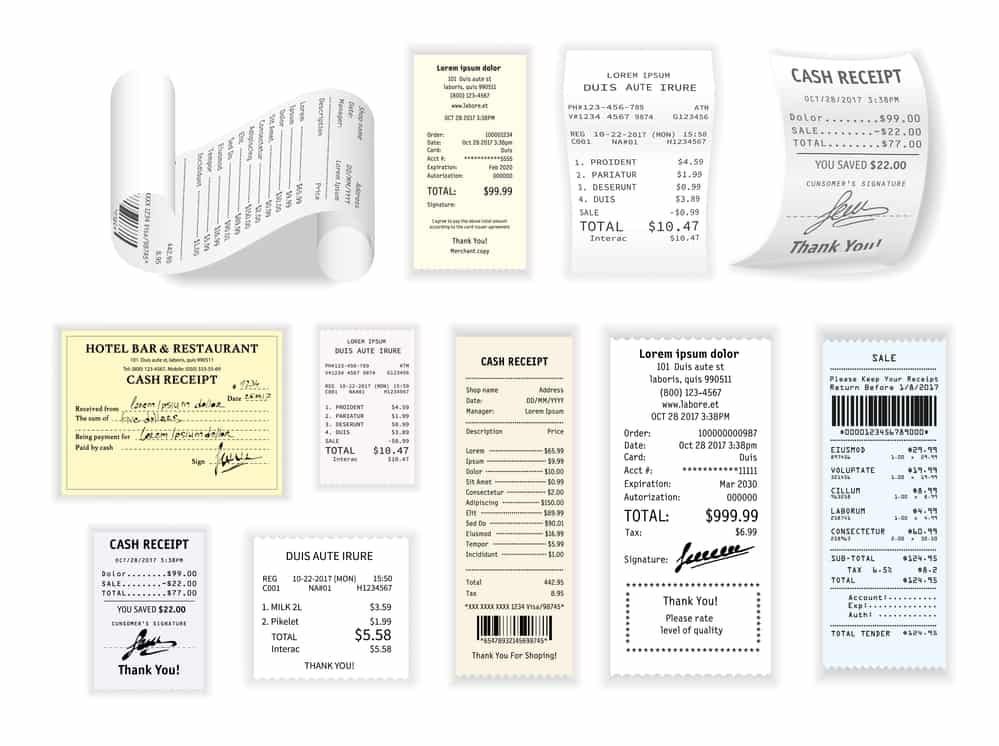This post may contain affiliate links, which means that we get commissions for purchases made through such links, at no additional cost to you. As an Amazon Associate we earn from qualifying purchases.
This article talks about the kind of paper used for receipts. our team noticed that receipt papers usually look different from standard papers. So we wanted to know what kind of paper is used for receipts. While researching this, we found out a lot more than we bargained for. As you read on, you will see all of our findings.
What kind of paper is used for receipts? Paper rolls used for receipts include thermal papers, wood-free papers, and carbonless papers. These are the three most used paper types for receipts. You can use any of them to print receipts but your choice would depend on your printer type, your budget, and your personal preferences.
In the sections that follow, we will tell you about these three paper types and how they differ from one another. We will also talk about why many people are not shifting from using paper receipts and embracing digital receipts instead.

The Most Common Paper Types for Receipts
The most common paper type people use for receipts is thermal paper rolls. But many people also use wood-free paper and carbonless paper. Thermal papers work only with thermal printers while wood-free papers work with all standard printers. Carbonless papers, on the other hand, are mainly designed for laser printers.
If you check with any receipt paper supplier, they may offer you both thermal paper rolls and bond paper rolls. This might confuse you if you didn’t know that there are different types of receipt papers. That’s why you should know the common receipt paper types and how to differentiate between them. That way, you’ll know the exact type to ask for when next you want to buy new paper rolls for printing receipts.
Thermal Paper
Thermal papers have heat-sensitive chemical coatings on their surfaces. As heat touches the thermal paper, its coatings would turn black or blue and produce text on the receipt paper. The paper’s thermal side which contains the thermal coating has a bright and smooth surface. The other (non-thermal) surface is without coating and will not change color under heat.
Thermal papers are the most common on the market for receipt printing. They are also cheap and easy to use since they don’t require toner or ink cartridges. They have become so popular that almost every retail store has a thermal printer for printing receipts. More so POS machines and ATMs use the thermal printing mechanism which requires thermal papers to print receipts.
✅ Video – Receipt Printer Paper: How to Choose the Right Type
You can’t use just any thermal paper roll on your thermal printer. A few variables, such as paper size and printer size, are important for choosing the right type. Watch this video to understand how to pick the appropriate receipt paper for your printing needs.
Wood-free Paper
Wood-free paper is more commonly known as bond paper. You can only use wood-free paper with traditional printers that use ink or toner cartridges but you can also print on them with thermal transfer printers which use ribbons. It is one of the staples in offices but the size often varies based on the document you’re printing with it. The A4 size is the most popular but a smaller size is used for receipts.
Difference Between Wood-free and Thermal Paper
There is a significant difference between wood-free papers and thermal papers. If you compare their surfaces, you’ll notice that wood-free papers have no coating on both sides while thermal papers are coated on one side. Wood-free papers, therefore, are not as smooth and bright as thermal papers.
More so, you will spend more if you are using wood-free paper for your receipts. They may cost less than thermal papers but they require you to incur the extra cost of buying ink cartridges regularly.
Carbonless Paper
You can also use carbonless paper to print receipts. These papers often contain two or three sheets. The customer would go with one copy while the other(s) will remain with the business owner. When you apply pressure on the first sheet to print your receipt, the “hidden” dye pigments on its back are released to the next sheet to replicate the receipt. The ripple effect from this also replicates the receipt on the third sheet.
Which Is the Best: Paper or Digital Receipts?
Paper receipts are more appropriate for face-to-face transactions but they also add to your inventory and could pose a serious health risk. Digital receipts, on the other hand, are cheaper and never damage (except you lost it without making appropriate backups. However, some customers would demand explanations for not getting paper receipts after their purchase.
Paper receipts do not require any information from the customer. In most cases, there is even no need for the customer’s name. But if you are issuing a digital receipt, you would require the customer’s name and phone number or email address.
However, thermal prints don’t last forever and they can’t be recycled. They are also more costly because you would need to buy a printer and receipt rolls, at least, before you can print paper receipts. But digital receipts only require internet connectivity to be sent.
Why Many People Are Shifting From Paper Receipts?
Thermal papers, the most popular paper type for receipts, often contain a toxic chemical, Bisphenol-A (BPA). BPA affects hormonal balance in humans and constant exposure to it is unsafe. These health concerns are making people shift away from paper receipts to start using digital receipts.
The option of using digital receipts is already gaining traction in many countries and across diverse industries. While this has obvious advantages, it also has disadvantages that one cannot overlook. However, digital receipts legally issued have the same authenticity as paper receipts.
The use of digital receipts started when online shopping became more popular. When people make online purchases, digital receipts are issued as proof of purchase. And since these are as valid in the eye of the law as paper receipts, it seems cheaper and safer health-wise to switch to digital receipts. But is it worth it?
What Are The Dangers Of BPA In Thermal Papers?
The human skin absorbs BPA and the body stores up this toxic chemical. As it increases in the body, it not only affects hormones but also increases heart disease risks, as well as many other health risks. More so, BPA makes the paper unrecyclable, which is also unhealthy for the environment.
The health risks of BPA increases with exposure. As such, a customer who seldom handles thermal receipts has minimal risk. The greatest risks are on store cashiers who work with thermal papers all day long and every day.
Related Questions
Is it OK to throw away credit card receipts?
You should only keep receipts that have pending or unresolved issues relating to them. Once you have settled your credit card bills, you should shred the receipts. This is very important if the receipt contains vital information about you, such as your name and address. More so, keeping unnecessary thermal receipts will increase your exposure to BPA, which could pose a health risk.
You should also destroy sales receipts when there is no pending warranty on the item or any matter relating to insurance or taxes. Keep pay stubs, medical bills, and bank statements for only a year and destroy them after that except there are unresolved issues, such as insurance disputes pending.
How are thermal papers different from regular papers?
One way to tell thermal papers apart from regular papers is to check the papers’ surfaces. Thermal papers always have a thermal surface, which contains the thermal coating. This surface is usually brighter and smoother than the other (non-thermal surface). But since regular papers have no thermal coating at all, there is no thermal surface and both sides of the paper look the same.
These two paper types are different because they were made for different purposes. Thermal papers are for thermal printers while regular papers are designed for standard office or home printers. Thermal papers use heat while regular papers use ink.
Can you use thermal paper in a regular printer?
It’s not only inappropriate to use thermal paper in a regular printer, but it is also useless because regular printers will not produce imprints on thermal papers. Thermal papers require heat, and that’s what thermal printheads release. Regular printers, on the other hand, release inks. Unfortunately, the slick surface of thermal papers cannot absorb ink.
Conclusion
I hope you were able to learn about the three common paper types used for receipt, and you now understand how they are different from one another. The article also explains why many people have been switching to digital receipts instead of paper receipts. With the knowledge shared in this article, you should be able to make an informed choice on how to cater to receipt printing for your business.
